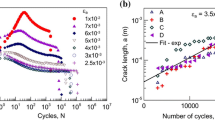Abstract
The microstructural features of aluminum alloy 7050-T7451 in the vicinity of fatigue cracks and on the crack path were studied to determine which of these features influence fatigue crack propagation. The studies included characterization of the full spectrum of microstructural and fracture surface features— from the largest (e.g., roughness and grain type) to the smallest (e.g., second-phase particles and dislocations). Of all the features studied, only the second-phase particles were shown to have a definite influence by causing crack deflection. The number of particles encountered by the fatigue cracks were significantly higher than the expected average. The fatigue crack path was predominately transgranular, and there was no change in the dislocation and precipitation structures in the crack-affected zone.
Similar content being viewed by others
References
S. Suresh,Fatigue of Materials, Cambridge University Press, 1991
A.K. Vasudévan, R.D. Doherty, and S. Suresh, Fracture and Fatigue Characteristics in Aluminum Alloys,Aluminum Alloys— Contemporary Research and Applications, Treatise on Materials Science and Technology, Vol 31, A.K. VasudéVan and R.D. Doherty, Ed., Academic Press, 1989, p 446
C.R. Owen, R.J. Bucci, and R.J. Kegarise, Aluminum Quality Breakthrough for Aircraft Structural Reliablility,J. Aircraft, Vol 26, 1989, p 178–184
A.J. Hinkle, P.E. Magnusen, R.L. Rolf, and R.J. Bucci, Effect of Microporosity on Notched Specimen Fatigue Life,Proceedings,of 5th International Conference on Structure Safety and Reliability, A. H-S. Ang., M. Shinozuka, and G.I. Schueller, Ed., American Society of Civil Engineers, 1989, p 1467–1474
J.R. Brockenbrough, R.J. Bucci, A.J. Hinkle, J. Liu, P.E. Magnusen, and S.M. Miyasato, “Role of Microstructure on Fatigue Durability of Aluminum Aircraft Alloys,” F33615-92-C-5915, Alcoa, 1993
M.A. Przystupa, J. Zhang, and A.J. Luévano, “Development of the Microstructure Based Stochastic Life Prediction Models,” N00014-91-J-1299, University of California Los Angeles, 1992—(available from Defense Technical Information Center, Bldg. 5, Cameron Station, Alexandria, VA 22304-6145)
J.K. Park and A.J. Ardell, Microstructures of the Commercial 7075 Al Alloy-in the T651 and T7 Tempers,Metall. Trans. A, Vol 14A, 1983, p 1957–1965
M.A. Przystupa, J. Zhang, and A.J. Luévano, “Development of the Microstructure Based Stochastic Life Prediction Models,” N00014-J-1299, University of California—Los Angeles, 1993 (available from Defense Technical Information Center, Buld. 5, Cameron Station, Alexandria, VA 22304-6145).
B.B. Mandelbrot:Fractal Geometry of Nature, W.H. Freeman, 1982.
E.L. Crow, F.A. Davis, and M.W. Maxfield, inStatistical Manual, Dover Publications, 1960, p 37
M.A. Przystupa, J. Zhang, and A.J. Luévano, “Development of the Microstructure Based Stochastic Life Prediction Models,” N00014-J-1299, University of California—Los Angeles, 1991 (available from Defense Technical Information Center, Buld. 5, Cameron Station, Alexandria, VA 22304-6145).
J. Zhang, A.J. Luévano, and M.A. Przystupa, Quantitative Analysis of Heterogeneous Grain Structure on Plane Sections,Scr. Metall. Mater.yol 26, 1992, p 1061–1066
R.C. Shah, Stress Intensity Factors for Through and Part-Through Cracks Originating at Fastener Holes, inMechanics of Crack Growth, STP 590, ASTM, 1976, p 429–459
O.L. Bowie,J. Math. Phys., Vol 35, 1956, p 60–71
D. Broek, inElementary Engineering Fracture Mechanics, 4th ed., Kluwer Academic Publishers, 1991, p 85
C. Laird, Mechanisms and Theories of Fatigue, inFatigue and Microstructure, American Society for Metals, 1978, p 149–204
F.-S. Lin and E.A. Starke Jr., The Effect of Copper Content and Deformation Mode of the Fatigue Crack Propogation of Al-6Zn-2Mg-xCu Alloys at Low Stress Intensities,Mater. Sci. Eng., Vol 45, 1980, p 153–165
E.J. Coyne Jr. and E.A. Starke Jr., The Effect of Microstructure on the Fatigue Crack Growth Behaviour of an Al-Zn-Mg-(Zr) Alloy,Int. J. Fract.,Vol 15(No. 5), 1979, p 405–417
F.-S. Lin and E.A. Starke Jr., The Effect of Copper Content and Degree of Recrystallization on the Fatigue Resistance of 7XXX-type Aluminum Alloy,Mater. Sci. Eng., Vol 43,1980, p 65–76
M.A. Wilkins and G.C. Smith, Dislocation Structures Near a Propagating Crack in an Al//2% Mg Alloy,Acta Metall., Vol 18, 1970, p1035–1043
Author information
Authors and Affiliations
Rights and permissions
About this article
Cite this article
Luévano, A.J., Przystupa, M.A. & Zhang, J. Accumulation of microstructural damage due to fatigue of high-strength aluminum alloys. JMEP 3, 47–54 (1994). https://doi.org/10.1007/BF02654498
Published:
Issue Date:
DOI: https://doi.org/10.1007/BF02654498




